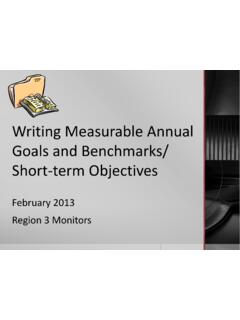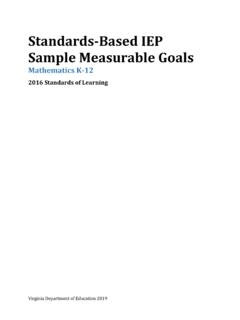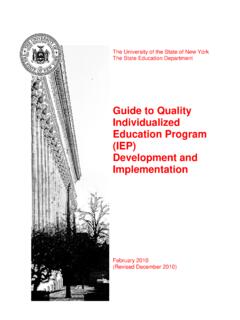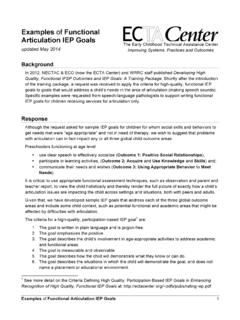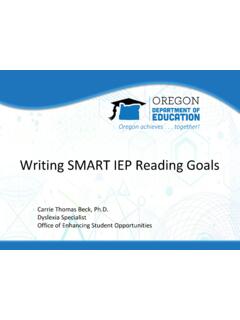Transcription of IEP Goal Writing for Speech-Language Pathologists
1 IEP Goal Writing for Speech-Language PathologistsUtilizing State StandardsLydia Kopel, EdS, CCC-SLPE lissa Kilduff, MA, CCC-SLPvContentsPrefacevii1 Early Learning Standards13 Year Olds 34 Year Olds 132 Common Core State Standards (CCSS)27 Kindergarten291st Grade 342nd Grade 403rd Grade 464th Grade 525th Grade 606th Grade 677th Grade 778th Grade 869th 10th Grade 9611th 12th Grade 1053 Prerequisite Skills and Steps to Mastery115 Vocabulary120 Questions125 Summarize129 Main Idea and Details 132 Critical Thinking 135 Pragmatics138 Syntax and Morphology 142 Articulation and Phonological Processes 1474 Writing IEP Goals151 What to Include in a Goal 156 Criteria for Mastery 159 Measuring Progress 160 Goal Examples 162 Appendix 4 1. Goal Writing Worksheet 182 References183 Index187viiPrefaceAs Speech-Language Pathologists (SLPs), we have a responsibility to support the state stan-dards. In order for students to be successful with the standards, they must have mastered specific Speech-Language skills.
2 There are three objectives of this book. First, to familiarize the SLP with specific Early Learning Standards and Common Core State Standards (CCSS) and the Speech-Language skills needed to be successful with these standards. The second objective is to outline prerequisite Speech-Language skills and steps to mastering those skills. The third objective, through a step-by-step process, is to write defensible IEP goals that are related to the information and process provided in this book are based on research, fifty years of combined experience as school-based SLPs and administrators, and reviewing Individual-ized Education Programs (IEPs) from all over the country. The authors developed this book as a result of reading hundreds of IEPs that had goals and objectives that were difficult to implement as written. This process has been field tested through a large metro school system with more than 175 1: early learning StandardS and cOmmOn cOre State StandardS and aSSOciated PrerequiSite Speech-Language SkillSEarly Learning Standards are the developmental building blocks for success in school.
3 These are focused on in Chapter 1. These standards were developed using the Head Start Early Learning Outcomes Framework: Ages Birth to Five (Office of Head Start, 2015) and individual state s early learning standards for three and four year olds. They are divided into the areas of Communication and Literacy, Math, Science, Social Studies, Cognition, Approaches to Learning, and Social and CCSS (National Governors Association Center for Best Practices [NGA Center] & Council of Chief State School Officers [CCSSO], 2010) requires a strong foundation of Speech-Language skills and these are the focus of Chapter 2. Standards have been pulled from all areas including English language Arts, Literacy in History/Social Studies, Science, Technical Subjects, and Mathematics. The standards are organized by grade level. Within each grade level the standards are organized by Common Core area, numbers, as indicated in the CCSS, and specific prerequisite speech and language skill(s) for that IEP Goal Writing for Speech-Language PatholoGIStSThe Early Learning Standards can easily be compared to the Early Learning Standards from each state.
4 In addition, for those SLPs whose state or school system has not adopted the Common Core State Standards, these can be compared to their adopted standards. This process can assist SLPs in identifying target skills within those 2: PrerequiSite SkillS and StePS tO maSteryChapter 3 consists of the Speech-Language skills that, in our experience, are the commonly addressed skills of intervention for students aged 3 years 21 years, with all levels of functioning. These skills are organized by the following Speech-Language areas: Vocabu-lary, Questions, Summarize, Main idea and Details, Critical Thinking, Pragmatics, Syntax and Morphology, and Articulation and Phonological Processes. Every speech and language skill has several prerequisite skills which have been outlined in Chapter 3. Each Prerequisite Skill then has corresponding Steps to Mastery that should be achieved in order to succeed with the state standards.
5 The Steps to Mastery are a hierarchy of levels from easiest to most difficult that should be accomplished for mastery of each Prerequisite 3: SteP-by-SteP PrOceSS tO Writing ieP gOalSOnce the SLP has identified the curriculum areas and specific standards that a student is struggling with, the Early Learning Standards in Chapter 1 and/or the CCSS in Chapter 2 should be reviewed. These standards identify specific prerequisite speech and language skills the student may be lacking. Next, the SLP would look up the Prerequisite Skills in Chapter 3 to determine which corresponding Steps to Mastery the student requires. The SLP then writes the IEP goal for the final Step to Mastery that the student can reasonably achieve in the course of the IEP. The Steps to Mastery can be easily developed into IEP goals . The Goal Writing Worksheet and information in Chapter 4 will assist the SLP with this process. It will also provide the framework for Writing defensible IEP goals .
6 The components of this framework include ensuring that the goals are understandable, doable, measurable , and achievable. An example of the goal Writing process is included , 5th Grader Classroom teacher reports that is having trouble with main idea andsupporting details. Identify the 5th-grade CCSS in Chapter 2 that align with the skills of main ix Go to the Main Idea & Details section in Chapter 3 and look at all the PrerequisiteSkills. The skills listed are:Comprehending questions SequenceMain idea when statedImportant versus unimportant detailsInfer/draw conclusionsMain idea and supporting details Decide where the student is currently functioning. In this case, can answerquestions and sequence. That means he would start with main idea when stated. Starting with main idea when stated, look at all the Steps to Mastery under eachof the subsequent Prerequisite Skills. Decide how many steps can reasonably achieve in the course of the IEP.
7 In thiscase, it is believed that get partway through the main idea and supportingdetails Steps to Mastery; up to Identify # details that support a given mainidea in a _____ (paragraph, story, poem, chapter, etc.). Write the goal using theGoal Writing will state three details that support a given main idea in a grade-levelpassage when read aloud to him in four out of five opportunities using book focuses on skills for mastery, not on activities. The activities will vary from student to student and need to reflect the Universal Design for Learning ( , using multiple means of representation, expression, and engagement) (Rose & Gravel, 2010).The concentration of this book is spoken language (receptive language , and expres-sive language ) and articulation. Reading and Writing are addressed through highlighting the underpinning language skills of reading and Writing standards. A student s ability and progress on a spoken language IEP goal should not be measured based on abilities with written language alone.
8 If we take away the expectation of reading and Writing , we can better measure if a student is struggling with comprehension versus basic reading, or the ability to formulate a cohesive thought versus the ability to write. According to Roles and Responsibilities of Speech-Language Pathologists with Respect to Reading and Writing in Children and Adolescents (ASHA, 2001), SLPs working in the school system are one member of a team with various areas of expertise. Spoken language should not be looked at in isolation but considered along with written language and addressed as a team. It is important for SLPs x IEP Goal Writing for Speech-Language PatholoGIStSto consider how students are using basic language knowledge and skills for the reading and Writing processes. However, as direct service providers, SLPs should focus intervention on the language skills that underlie and impact the ability to acquire reading and Writing . The SLP can then collaborate with other professionals in the school who provide interventions related to written language .
9 Written language materials are imperative as part of spoken language intervention. SLPs should not be working on listening comprehension in the absence of reading material or oral expression in the absence of is not intended to be an exhaustive list of Speech-Language skills. It is intended to target the common skills that SLPs focus on in the school system. There are many other skills that can be addressed as goals on a student s IEP. The key to remember is that the goal must be understandable, doable, measureable, and achievable. goals are an ending point, not a beginning book provides clear guidelines of quantifiable building blocks to achieve specific goals defined by the child s IEP. SLPs are instrumental in helping students develop speech and language skills essential for mastery of the standards. With a clear understanding of early learning standards, state standards, prerequisite skills, and steps to mastery, interven-tions will be successful to help students achieve their IEP goals and have success with the Skills and Steps to MasteryThe Speech-Language skills in this chapter are organized into the following areas: Vocabulary Questions Summarize Main Idea and Details Critical Thinking Pragmatics Syntax and Morphology Articulation and Phonological ProcessesThese areas were selected as they are major domains of language development and common areas requiring Speech-Language intervention.
10 Each area includes a brief explanation followed by a listing of Prerequisite Skills and corresponding Steps to index of prerequisite skills has been provided in Table 3 1 so the SLP can easily locate the skills identified in Chapters 1 and 3 1. Index of Prerequisite SkillsPrerequisite SkillSpeech- language areaadjectivesVocabularyadverbsVocabular yanswer factual questionscritical thinkingantonyms/synonymsVocabularyartic lesSyntax and morphologyask a question QuestionscategorizeVocabularycause/effec t Questionscritical thinkingComparatives/superlativesVocabul arySyntax and morphologyCompare/contrastVocabularycrit ical thinkinganswer questions:yes/noWhatWhereWhoWhenWhy how Questionsmain idea and detailsSummarizeConceptsVocabularyconjun ctionsSyntax and morphologyConversational repairsPragmaticsdescribeVocabularyFact/ opinioncritical thinkingfigurative languagecritical thinkingPragmaticsfuture tenseSyntax and morphology117 Prerequisite SkillSpeech- language areaGreetings/farewellsPragmaticsIdentif y own emotionsPragmaticsIdentify what information is neededQuestionsimportant versus unimportant detailsmain idea and detailsSummarizecritical thinkingInfer/draw conclusionsQuestionsmain idea and detailscritical thinkingInitiating conversationPragmaticsmain ideamain idea and detailsmatchVocabularymeaning from contextVocabularymultiple meaning wordsVocabularynarrative elementsQuestionsSummarizenegationVocabu larynonliteral languagecritical thinkingPragmaticsnonverbal cuesPragmaticsnounsVocabularyPast tenseSyntax and morphologyPluralsSyntax and morphologyPossessivesSyntax and


